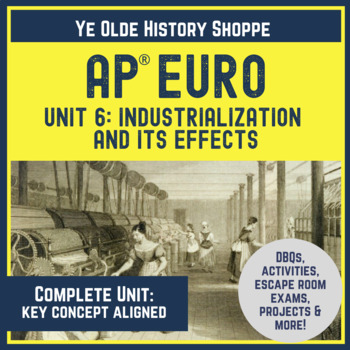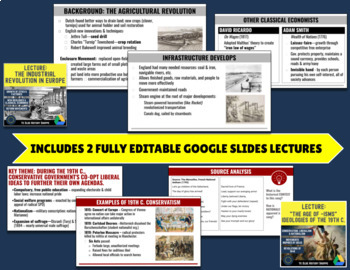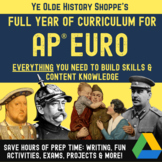AP Euro Unit 6: Industrialization & Effects - Digital: DBQs, Exam & Activities
- Google Drive™ folder

What educators are saying
Products in this Bundle (12)
showing 1-5 of 12 products
Bonus
Also included in
- Teach content and skills simultaneously for your AP® European History class. Save time planning with these comprehensive bundles for the entire YEAR! (Over 100 activities) Cover the material in a fun, comprehensive and rigorous way that is directly aligned with the College Board®'s key concepts. ThiPrice $250.00Original Price $382.76Save $132.76
Description
Whether you are a new AP® Euro Teacher teacher or a veteran looking to shake things up, this unit pack can help guide your students to the content and skills needed for success on the AP® Exam. Reduce stress and planning time with this Complete Unit Pack. Teach skills & content simultaneously! This unit is designed to supplement all the major AP® Euro textbooks. The bundle includes links to bonuses like EdPuzzles on AP® Euro Crash Course videos and Assessments (both multiple choice & SAQs).
All assignments are easily modifiable in Google Slides™ form and can be printed or assigned digitally through Google Classroom or any other LMS. These lessons will help engage students and guide them through UNIT 6: Industrialization & its effects in the 19th century.
NOTE: AP® is a trademark owned by the College Board, which is not affiliated with, and does not endorse, this product/site
THIS UNIT BUNDLE IS...
- student-centered
- no-prep
- digital or printable
- fully editable
- requires no textbook or outside resources other than computer access
Check out each assignment in the PREVIEWS!
LEARNING TARGETS COVERED:
- I can explain why the Industrial Revolution began in Britain, including the effects of the Agricultural Revolution.
- I can explain the ways in which industrialization changed people’s lives positively and negatively, including short-term and long term effects.
- I can describe the various ideas on how to improve the lives of workers during the 19th century.
- I can explain the extent to which suffrage was extended over the course of the 19th century.
- I can compare and contrast the ideas and goals of 19th century socialists.
- I can explain the political and economic ideas of liberals in the 19th century.
- I can explain the emergence of nationalism in the 19th century and analyze its effects.
- I can describe the ideals of conservatism and policies of conservative leaders in the 19th century.
- I can analyze the causes and outcomes of the Revolutions of 1848.
UNIT PLAN:
1. DIGITAL NB Intro to the Industrial Revolution (approx time: 60 minutes)
KC 6.2 [corresponds to the College Board Course Exam Description] - TEXTBOOK ALIGNMENT: McKay CH 21; Kagan CH 21; Spielvogel CH 20
Topics Include:
- the agricultural revolution and how it led to the industrial revolution
- why it began in Britain
- new inventions in the textile industry
- Transportation
- and more!
EXTENSION & ENRICHMENT:
LINK: Manchester Case Study Analysis [adapted from the 2002 DBQ] Printable PDF version only
SUGGESTED HOMEWORK/EXTENSION:
BBC: The Industrial Revolution in Britain EdPuzzle (33 minutes)
You will need to make a copy and assign to your class through EdPuzzle -- do not post this link or you won’t be able to see students’ results!
2. The Industrial Revolution Causes & Effects ESCAPE ROOM (approx time: 60 minutes)
KC 6.3 - TEXTBOOK ALIGNMENT: McKay CH 21; Kagan CH 21; Spielvogel CH 20
This content-driven Escape Room will allow students to explore the causes and effects of the Industrial Revolution in Europe during the 18th & 19th century. Includes a student Note Sheet & a Google Forms escape room that can be used in class or in distance learning. Have students team up to see who can crack the codes first!
The Teacher Guide includes links to the Google Form & worksheet.
3. Effects of the Industrial Revolution Gallery Walk (approx time: 60 minutes)
KC 5.4 - TEXTBOOK ALIGNMENT: McKay CH 21; Kagan CH 21; Spielvogel CH 20
This assignment can be done as a GALLERY WALK in class or digitally. Each topic includes a 1 page reading and 2-3 pages of additional sources: images, charts, primary sources, etc. You can also print and put the sources in file folders. Laminating the handouts makes it easier to re-use (& to clean in the time of COVID)
For the DIGITAL VERSION, the documents are linked in the instruction slide. Depending on your school's sharing settings, you may need to link the readings in from your own Google Drive. (see folder for a Google Docs version of the informational handouts)
IDEAS FOR EXTENSION & ENRICHMENT:
Time permitting, you can have students discuss the following. A written response can also serve as an exit ticket
Suggested questions:
- What effect of the Industrial Revolution was most significant and why?
- What opportunities & hardships were created during the Industrial Revolution?
- Why did the Industrial Revolution affect workers so negatively at first?
4. PPT: INDUSTRIAL REVOLUTION
TEXTBOOK ALIGNMENT: McKay CH 21; Kagan CH 21; Spielvogel CH 20
Can be reviewed in class or posted for student review in a flipped classroom model.
TOPICS INCLUDE:
- Context & Causes: The Agricultural Revolution
- Why it began in England
- Population Shifts & growth of infrastructure
- Classical Economists: Malthus, Ricardo & Smith
- Textile Industry & Proletarianization
- Child Labor video
- Chartists
- Anti-Corn Law League
- Utopian Socialists
- Marxists & Anarchists
5. Conservatism & Reactions to Revolutions Yearbook (approx time: 4-5 hours for individual work. Less if students work in groups)
KC 6.5 & 6.6 - TEXTBOOK ALIGNMENT: McKay CH 22; Kagan CH 20 & 21; Spielvogel CH 21
This project can be completed individually or in groups of up to 4 (there are 4 different categories)
Students will fill in the template by applying information in the following 4 categories:
- MEMORIES OF IMPORTANT EVENTS: July Days, Corn Laws & Six Acts, Reform Bill of 1832, Greek & Serbian Independence, Decembrist Revolt, Potato Famine, and Revolutions of 1848
- “I HAVE A DREAM” -- important figures’ visions for Europe & the world: Metternich, Bolivar, Owens, Marx, Charles X, Lord Byron, and more!
- STUDENT GROUPS & CLUBS: Carbonari, Burschenschaften, Socialists United, Conservative Coalition, Nationalist League, and Suffrage Society.
- SUPERLATIVES: students create their own "most" and "least" categories!
SUGGESTED HOMEWORK/EXTENSION:
Reform & Revolution 1815 - 1848 EdPuzzle
You will need to make a copy and assign to your class through EdPuzzle -- do not post this link or you won’t be able to see students’ results!
6. Ideologies Intro NB (approx time: 45 minutes)
KC 6.7 - TEXTBOOK ALIGNMENT: McKay CH 22; Kagan CH 20 & 21; Spielvogel CH 21
This digital interactive notebook covers the major ideologies that emerged during the Industrial Revolution: Communism, Capitalism, Socialism, Liberalism & Conservatism. Students will learn about the concepts, check their understanding, and apply the ideologies to the issues of the Industrial Revolution. The accompanying teacher lecture on Google Slides will help review key concepts with your class.
7. -ISMs BINGO (approx time: 30 minutes)
KC 6.7 - TEXTBOOK ALIGNMENT: McKay CH 22; Kagan CH 20 & 21; Spielvogel CH 21
To review the important “-isms” of the 19th century, play this fun BINGO game with your students. You will review the following ideologies: Communism, Capitalism, Socialism, Liberalism, Conservatism, Nationalism & Romanticism.
There is a teacher PPT with 25 slides & a seperate file for the fillable student BINGO card. Students will pre-fill their BINGO card according to the instructions on slide 3. Allow 2-3 minutes for students to fill in the top part of the card with the -ISMs. (This must be done before the game starts!)
This card can be printed or completed digitally. Students will either yell out the ANSWERS or type the answer into the chat box.
8. Women’s Suffrage Digital NB or Pear Deck
KC 6.8 - TEXTBOOK ALIGNMENT: McKay CH 22; Kagan CH 20 & 21; Spielvogel CH 21
This digital interactive notebook (with Pear Deck option) allows students to explore the Suffrage Movement in Britain by analyzing primary sources (both images & pamphlets), visiting curated web resources, and watching a short video.
Students will examine the strategies used by Suffragists and more militant Suffragettes like Emmeline Pankhurst, analyze primary sources, and learn about the Representation of the People Act of 1918.
9. PPT: THE AGE OF -ISMs
TEXTBOOK ALIGNMENT: McKay CH 22; Kagan CH 20 & 21; Spielvogel CH 21
TOPICS INCLUDE:
- Context
- Nationalism: a unifying & divisive force with source analysis
- Romanticism - art & literature
- Conservatism: Congress of Vienna, Tories, Peterloo, Carlsbad Decrees, Charles X etc.
- Liberalism: Whigs, Chartists, Anti-Corn Law League, etc.
- Revolutions in France & Revolutions of 1848
- Socialism
- Communism
10. Reformer Convention (approx time: 2 days)
KC 6.7, 6.8 & 6.9 - TEXTBOOK ALIGNMENT: McKay CH 22; Kagan CH 20 & 21; Spielvogel CH 21
Students will analyze the effects of the Industrial Revolution through the lens of different groups/ideologies. Includes a rubric for grading. This can be done in class (as an in-person conference) or can be done digitally (either live or recorded on FlipGrid). Students can work in groups or individually.
Allow 1-2 days for prep and one full class period for the conference.
The groups included are:
- Labor Unions
- Communists
- Socialists
- Capitalists
- Factory Workers
- Factory Owners
11. Unit 6 Timeline Review [BONUS RESOURCE]
Assignment LINKED (you will need to make a copy). This can be distributed as a reference for students or you can require students to fill it in as a study guide for the unit.
Why do timelines matter? As an AP Exam Reader, I learned that many students lose out on points because they do not have a chronological understanding and use evidence from outside the time of the question. By having students review timelines (not to memorize dates but to understand the flow of events), they maximize their chances of picking relevant examples on free response questions and can make better inferences on multiple choice questions.
12. Review Challenge
This activity covers main ideas from the unit and allows students to develop critical thinking skills that can be helpful on the exam. Question types include chronology of events (to practice deducing and reviewing the flow of events), T or F, fill in the blank, and quote identification. It is suggested you allow no more than 30 minutes for students to complete, working in groups. Then, exchange papers and have students peer grade. I like to give prizes to the team(s) with the most correct answers!
13. EXTENSION & APPLICATION: Dickens & the French & Industrial Revolution Mini-unit
This Mini Unit should take approximately one week. (1-2 days for the overview & Tale of Two Cities analysis and 2-3 days to watch the film) It is best at the end of the Industrial Revolution unit to tie together themes from the Industrial Revolution & look back at the French Revolution.
It can be completed in 1-2 days if you just analyze the excerpts rather than watching the film.
ASSESSMENT:
MULTIPLE CHOICE EXAM - 45 questions (click the link to access the exam. You will need to make a copy to modify the questions)
NOTE: Questions 1 - 26 are mostly industrial revolution & questions 27 - 45 are mostly focused on the “-isms” and revolutions 1830 -1848
DBQs
OPTION 1: DBQ - ADAPTED FROM THE 2012 DBQ: Analyze various arguments that emerged over the course of the nineteenth century about how to improve the lives of European workers.
2012 scoring guide can be found HERE, but note document numbers are different as the 2012 DBQ had 12 documents and this has been reduced to 7 to reflect the current DBQ structure
OPTION 2: DBQ - Analyze the ideas that emerged regarding the creation of political stability and identify the challenges to creating this stability (1790 - 1820).
-----------------
Looking for extra AP Euro DBQs? I have a set of 9 original DBQs. Check out all my AP European History Resources HERE.
I am posting a full year of AP Euro Curriculum this Summer. Please follow my store to get notifications when new resources are released.
Please let me know if you have questions. You can email me at yeoldeushistoryshoppe@gmail.com and I am happy to help.
_______________
DID YOU KNOW?
_______________
You can follow my store by clicking HERE. Be the first to know when I release new products or hold a sale!
You can also earn TPT credit to use on future purchases by reviewing products?
Just go to your My Purchases page. Next to each of your purchases, you'll see a Provide Feedback button. Click that link and you will be taken to a page where you can rate the product and leave a review. Each time you give feedback, TPT gives you feedback credits that you can use to lower the cost of your future purchases!






